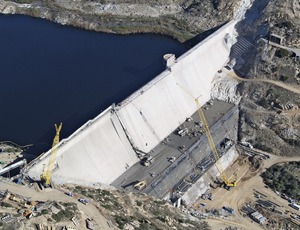
Construction on the world's largest dam-raise project of its kind wrapped up this summer, providing the San Diego County Water Authority with an additional 152,000 acre-ft of water, more than doubling the capacity of the St. Vincente reservoir.
The project involved removing two inches from the surface of the original St. Vincente dam, then using roller-compacted concrete to add—in layers, one on top of the other—an additional 117 ft up from the new foundation. The new dam stands at 337 ft tall.
The $415.9-million project is part of a larger $1.5-billion emergency storage project in the San Diego region. Conceived during the 1990s as a way to have additional water storage in the event of a seismic event or other emergency, the project is coming on line at a critical time, says Dana Friehauf, the authority's water-resources manager. "Now that the science [about climate change] is out there, the science is clear—that's why this project is even more important in regards to adaptation to climate change," she says.
In addition to the dam raise, the emergency storage project involved the construction of an interconnected system of reservoirs, pipelines and pumping stations, designed to make water available to the region in times when water is scarce or unavailable because of an emergency event or drought.
The system will provide up to six months of emergency water storage at three reservoirs. During wet seasons, the filled reservoirs allow that water to be used in times of scarcity, Friehauf says. Final ancillary work continues into 2016.


Post a comment to this article
Report Abusive Comment